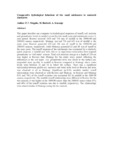Please use this identifier to cite or link to this item:
https://cris.library.msu.ac.zw//handle/11408/4220Full metadata record
| DC Field | Value | Language |
|---|---|---|
| dc.contributor.author | Mugabe, Francis T. | |
| dc.contributor.author | Hodnett, M. | |
| dc.contributor.author | Senzanje, A. | |
| dc.date.accessioned | 2021-05-20T13:35:33Z | |
| dc.date.available | 2021-05-20T13:35:33Z | |
| dc.date.issued | 2007 | |
| dc.identifier.issn | 0140-1963 | |
| dc.identifier.uri | https://www.sciencedirect.com/science/article/abs/pii/S0140196306004174 | |
| dc.identifier.uri | https://doi.org/10.1016/j.jaridenv.2006.11.016 | |
| dc.identifier.uri | http://hdl.handle.net/11408/4220 | |
| dc.description.abstract | This paper describes and compares the hydrological responses of runoff, soil moisture and groundwater levels to rainfall events for two small semi-arid catchments over a 2-year period. Romwe received 1430 and 756 mm of rainfall in the 19999/00 and 2000/01 season, respectively. Mutangi received 756 and 615 mm of rainfall in the same years. Romwe generated 520 and 102 mm of runoff in the 19999/00 and 2000/01 seasons, respectively, while Mutangi generated 82 and 69 mm of runoff in the same years. The runoff response of the catchments was dominated by a relatively quick response to rainfall and with little or no significant contribution from regional groundwater or ‘old water’ sources. Total soil moisture storage to a depth of 120 cm was higher at Romwe than Mutangi for the entire study period reflecting the differences in the soil types. The groundwater level was closer to the surface and responded more quickly to rainfall at Romwe compared to Mutangi where water levels were between 12 and 16 m below the surface. There was a significant relationship between profile soil moisture and water table level at Romwe and none was observed at all in Mutangi. Significant (p<0.05) monthly rainfall runoff relationships were observed at both Romwe and Mutangi. At Romwe and Mutangi 91% and 76% of the runoff variation was accounted for by rainfall in the 1999/00 season, respectively. The rainfall–runoff relationship were different at Romwe for the two seasons, it was higher in the 1999/00 season than the 2000/01 season when 91% and 49% of the runoff variation was due to rainfall, respectively. The relationships were almost similar at Mutangi during the two seasons. | en_US |
| dc.language.iso | en | en_US |
| dc.publisher | Elsevier | en_US |
| dc.relation.ispartofseries | Journal of Arid Environments;Vol. 69; No. 4: p. 599-616 | |
| dc.subject | Semi-arid | en_US |
| dc.subject | Catchment hydrology | en_US |
| dc.subject | Soil moisture | en_US |
| dc.subject | Water table | en_US |
| dc.subject | Runoff | en_US |
| dc.title | Comparative hydrological behaviour of two small catchments in semi-arid Zimbabwe | en_US |
| dc.type | Article | en_US |
| item.languageiso639-1 | en | - |
| item.openairetype | Article | - |
| item.openairecristype | http://purl.org/coar/resource_type/c_18cf | - |
| item.cerifentitytype | Publications | - |
| item.fulltext | With Fulltext | - |
| item.grantfulltext | open | - |
| Appears in Collections: | Research Papers | |
Files in This Item:
| File | Description | Size | Format | |
|---|---|---|---|---|
| Document1.pdf | Abstract | 63.4 kB | Adobe PDF |  View/Open |
Page view(s)
188
checked on Nov 24, 2025
Download(s)
26
checked on Nov 24, 2025
Google ScholarTM
Check
Items in MSUIR are protected by copyright, with all rights reserved, unless otherwise indicated.



